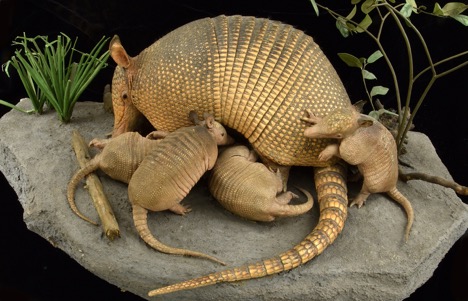Which Animal Almost Always Gives Birth To Identical Quadruplets?

Armadillos are placental mammals that first appeared in the fossil record in South America 60 meg years ago. Today, in that location are 21 species, only i of which is found in North America—the nine-banded armadillo, Dasypus novemcinctus.
All armadillos accept a protective shell, or carapace, made of bony plates in the skin. These osteoderms not only cover the trunk, but the head, limbs, and, except for the naked-tail armadillo, even the tail. Armadillo in Castilian ways "little armored 1," but the Aztec proper name is more descriptive, translating to "turtle-rabbit." The carapace of the nine-banded armadillo has 2 major shields, one at the shoulders and the other at the pelvis, continued by a series of overlapping bands, which provide some degree
of flexibility. Equally you can guess from its name, there are usually ix such bands in Dasypus novemcinctus (as in the female parent pictured here), but this varies from seven to 10. The underbelly is not similarly protected with osteoderms, merely the skin is tough and leathery.
Dasypus novemcinctus, Nine-banded Armadillo
The evolution and biology of the ix-banded armadillo, the land small-scale mammal of Texas, have fascinated me for years. Nonetheless, considering we just historic Mother'south Solar day, I want to comment on the amazing armadillo mother. Dasypus novemcinctus is the only vertebrate that gives nativity to identical quadruplets every time! A female produces a single egg that, once fertilized, splits into four genetically identical embryos that share one placenta. How and why this unique pattern evolved and continues to exist maintained is a mystery. We usually consider genetic variety a plus for organisms with multiple births as
it increases the chances that some offspring will survive in an ever-changing environs, but the 9-banded armadillo bucks this by producing clones.
Other than making milk for her young, the nine-banded armadillo mother is non particularly attentive, and the father is fifty-fifty less so. Notwithstanding, perhaps her major role is providing sufficient diet for her young to grow and prosper. Building a bony carapace requires extra nutrients, primarily calcium, and phosphate. Although ossification of the osteoderms begins in utero, you tin imagine that birth (of four babies no less!) is facilitated by them having a sparse and flexible carapace, that is, 1 that
is not fully formed. Indeed, thankfully, most of the carapace's development occurs subsequently birth.
The armadillo mother makes this all happen largely on an insectivorous diet, a by and large poor source of calcium. Add to that, armadillos accept a lower metabolic rate than most mammals. Somehow, despite these perceived handicaps, the immature built-in at 100 grams (less than a quarter pound) grow rapidly and are able to forage for themselves at two months. How the armadillo mother is able to do all this for her four identical babies is as mysterious every bit how she had four identical babies in the get-go place.
John Wible, PhD, is curator of mammals at Carnegie Museum of Natural History. He studies the evolutionary history of mammals and lives in a house full of them, some human (married woman and 2 sons) and some not-human (cats, rabbits, and guinea pigs).
Carnegie Museum of Natural History Blog Commendation Information
Weblog writer: John Wible
Publication date: May 22, 2017
Share this post!
Source: https://carnegiemnh.org/armadillo-identical-quadruplets-every-time/
Posted by: knightllostastings.blogspot.com

0 Response to "Which Animal Almost Always Gives Birth To Identical Quadruplets?"
Post a Comment